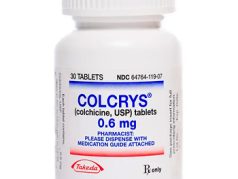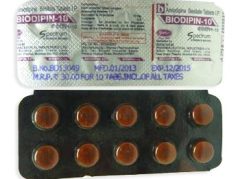Indocid

Indocid
- In our pharmacy, you can buy Indocid without a prescription, with delivery in 5–14 days throughout Australia. Discreet and anonymous packaging.
- Indocid is used for the treatment of various inflammatory conditions, including osteoarthritis, rheumatoid arthritis, ankylosing spondylitis, and acute gouty arthritis. It works as a non-steroidal anti-inflammatory drug (NSAID) by inhibiting the production of prostaglandins involved in inflammation and pain.
- The usual dosage for adults varies: 25 mg 2-3 times daily for arthritis, 50 mg 3 times daily for acute gout until relief, and 25-50 mg 2-3 times daily for pain/inflammation.
- The form of administration is available in capsules, oral suspension, suppositories, and injectable forms.
- The onset time for Indocid generally begins within 2–4 hours for pain relief.
- The duration of action is approximately 4–6 hours, depending on the form administered.
- It is advised not to consume alcohol while taking Indocid, as it may increase the risk of gastrointestinal side effects.
- The most common side effect is gastrointestinal upset, including nausea, vomiting, and in some cases, dizziness and headache.
- Would you like to try Indocid without a prescription?
Basic Indocid Information
- International Nonproprietary Name: Indomethacin
- Brand names available in Australia: Indocid, Indomethacin
- ATC Code: M01AB01
- Forms & dosages: Capsules (25 mg, 50 mg), Suppositories (50 mg, 100 mg), Oral Suspension (25 mg/5 mL)
- Manufacturers in Australia: Various, including Merck Sharp & Dohme
- Registration status in Australia: Prescription only (Rx)
- OTC / Rx classification: Prescription Only
Critical Warnings & Restrictions
Indomethacin (brand name Indocid) is a powerful non-steroidal anti-inflammatory drug (NSAID) that comes with critical safety warnings, especially for vulnerable groups. Pregnant women, particularly in the third trimester, should avoid this medication due to risks of complications for both mother and baby. Indomethacin is not a suitable option during pregnancy, and alternatives should be explored with healthcare providers. Elderly patients and individuals with chronic illnesses such as heart failure, renal impairment, or gastrointestinal disorders should use indomethacin cautiously. These groups are more susceptible to adverse effects and require careful monitoring. Patients engaging in daily activities that require focus, such as driving or operating machinery, must be aware that indomethacin can cause dizziness and gastrointestinal effects. It's important to be informed about these potential impacts on workplace safety, as stipulated under Australian law.Can I Drive After Taking It in Australia?
Driving after taking indomethacin can be risky if you experience dizziness or drowsiness. Consult with your healthcare provider before engaging in activities requiring concentration.Usage Basics
Indomethacin’s International Nonproprietary Name (INN) is Indomethacin, and it is marketed under various brand names, including Indocid in Australia. This medication is classified as Prescription Only (Rx) by the Therapeutic Goods Administration (TGA), ensuring that it is dispensed with a doctor's oversight. Additionally, Indomethacin is listed on the Pharmaceutical Benefits Scheme (PBS), making it accessible to eligible Australian patients at subsidised prices through pharmacies. Patients can find Indocid available in various formulations, including capsules, suppositories, and oral suspension, ensuring flexibility in administration.Dosing Guide
The dosing regimen for indomethacin varies based on the condition being treated and individual patient response. For osteoarthritis, rheumatoid arthritis, and ankylosing spondylitis, the typical initial dose is 25 mg, two to three times daily. Adjustments can be made as needed, with a maximum of 200 mg per day. For acute gouty arthritis, the immediate treatment begins at 50 mg, three times daily until symptoms improve, generally not surpassing 200 mg over a short duration. When addressing general pain and inflammation, the dosing generally ranges between 25-50 mg, administered two to three times daily as deemed appropriate by a healthcare professional. Pediatric use for indomethacin is highly specialised and rarely indicated in young children. It requires expert supervision to ensure optimal safety and efficacy. It's important to note that elderly patients should initiate treatment at the lower dosing range, allowing careful monitoring for any potential side effects.What If I Miss A Dose?
If you miss a dose of indomethacin, take it as soon as you remember, unless it's near the time for your next dose. It’s crucial not to double up on doses, as this can lead to increased risk of side effects.Interaction Chart
When using Indomethacin, also referred to as Indocid, it's crucial to consider interactions with food, beverages, and other medications. Limiting alcohol consumption is important as it can heighten gastrointestinal risks associated with NSAIDs, leading to potential bleeding and ulcer formation.
While coffee and various caffeinated drinks don't have direct contraindications, they may elevate gastric acidity, so individuals should monitor for any discomfort that arises after consumption.
Moreover, drug interactions cannot be overlooked. Combining Indomethacin with anticoagulants increases the risk of bleeding complications. Patients are also cautioned against using Indomethacin alongside other NSAIDs or corticosteroids due to a heightened potential for gastrointestinal problems. It's vital for patients to disclose all medications, including over-the-counter products and supplements, to their healthcare providers.
Older adults or individuals with chronic health issues should have their medication regimen adjusted only under precise medical supervision. Consulting with healthcare providers ensures safe usage while minimising adverse interactions.
User Reports & Trends
Feedback from Australian patients regarding Indocid reflects a range of experiences. Health platforms such as ProductReview and local health forums highlight its effectiveness for acute gout and pain management, with patients often reporting relief within just a few hours of taking the medication.
However, gastrointestinal side effects such as nausea and heartburn are common complaints. Many users suggest that taking the medication with food helps to alleviate these effects. An uptick in usage trends is observed, largely attributed to PBS subsidies increasing accessibility.
Healthcare professionals encourage patients to provide consistent feedback to enhance understanding of Indomethacin's impact and develop tailored advice for managing side effects.
Access & Purchase Options
In Australia, Indomethacin is readily available at major pharmacy chains including Chemist Warehouse, Priceline, and TerryWhite Chemmart. The medication is listed on the Pharmaceutical Benefits Scheme (PBS), allowing eligible patients to purchase it at reduced costs based on their specific healthcare coverage.
With the growth of online pharmacies, patients also have the option of obtaining Indomethacin through e-prescriptions via telehealth services, particularly beneficial for individuals living in rural regions with limited access to physical pharmacies. These online consultations facilitate acquiring prescriptions without the need for in-person visits, enhancing overall accessibility.
It’s essential for patients to ensure they acquire medications from TGA-approved suppliers to avoid counterfeit products. Checking pharmacy accreditations and reading user reviews can guide safe purchasing decisions.
Mechanism & Pharmacology
Indomethacin operates as a potent non-steroidal anti-inflammatory drug (NSAID) primarily by inhibiting the enzyme cyclooxygenase (COX). This inhibition leads to a reduction in the production of prostaglandins, the compounds responsible for inflammation, pain, and fever.
Its pharmacological impact becomes evident quickly, with the anti-inflammatory effects commencing within two to four hours post-administration. This rapid relief is particularly valued in handling gout flares.
Depending on the formulation, absorption rates can vary. Oral dosages generally peak plasma concentrations within this two to four-hour window. The half-life of Indomethacin is about 4.5 hours, necessitating dosing up to three times daily under standard conditions.
Grasping the pharmacodynamics, alongside individual patient variations, enables healthcare providers to utilise Indomethacin effectively while minimising associated risks.
Indications & Off-Label Uses
Indomethacin, commonly known by the brand name Indocid, plays a vital role in treating various inflammatory conditions. Singapore's Therapeutic Goods Administration (TGA) endorses its use primarily for osteoarthritis, rheumatoid arthritis, and ankylosing spondylitis. It serves as an effective option for managing acute pain linked to these disorders.
The medication is particularly renowned for addressing gout attacks, showcasing a rapid onset of action that alleviates pain and swelling in these acute episodes.
Beyond its established indications, indomethacin finds off-label application within Australian clinical practice. Healthcare professionals may use it for conditions such as tendonitis, bursitis, and various soft tissue injuries, especially when conventional pain relief strategies fall short. However, it’s crucial to monitor patient responses closely for any adverse effects.
While exploring indomethacin as a treatment alternative, practitioners should prioritise careful patient selection, given the associated risks of gastrointestinal and renal complications. Regular follow-up consultations to assess effectiveness and tolerability are recommended.
Key Clinical Findings
Recent clinical studies spanning from 2022 to 2025 have reaffirmed indomethacin’s effectiveness, particularly in managing acute gout attacks and chronic pain conditions. Published findings in reputable medical journals point to its superior capacity for reducing inflammation faster than some alternative NSAIDs.
While the efficacy is notable, studies have also highlighted a concerning higher occurrence of gastrointestinal adverse events, notably among elderly patients and those with pre-existing health conditions. This creates an essential need for careful patient evaluation before prescribing.
Research findings advocate the combination of indomethacin with gastroprotective agents, especially for at-risk groups, to curb potential side effects. Furthermore, the emphasis on personalised therapy underscores the necessity of considering factors such as dosage, patient age, and existing health conditions when tailoring treatment plans.
Alternatives Matrix
For individuals seeking alternatives to indomethacin, the Pharmaceutical Benefits Scheme (PBS) provides access to several comparable medications, such as Diclofenac, Naproxen, and Ketoprofen.
| Medication | Indications | Recommended Dosage | Notes |
|---|---|---|---|
| Diclofenac | Osteoarthritis, acute gout | 25-75 mg, 2-3 times/daily | Generally well-tolerated |
| Naproxen | Acute gout, inflammation | 250-500 mg, 2x daily | Long duration effect |
| Ketoprofen | Arthritis, tendonitis | 50-100 mg, 3x daily | Potential GI side effects |
- Pros: Alternative options available for those not tolerating indomethacin.
- Cons: Similar GI and renal risks necessitating monitoring in older adults.
Common Questions
Patients often have various queries about Indocid during their pharmacy visits. Here are some common inquiries:
Q: Can I take indocid and panadol together?
A: Yes, Indomethacin can generally be taken with paracetamol (Panadol) as they act through different mechanisms. Always verify with a healthcare provider.
Q: How long does indocid suppository take to work?
A: Indomethacin suppositories usually begin to take effect within 1-2 hours.
Q: Is indocid safe during pregnancy?
A: Indomethacin is generally advised against during pregnancy, especially in the third trimester.
Addressing these questions enhances patient understanding, which can improve adherence to treatment and ensure safety and effectiveness.
Delivery Information
| City | Region | Delivery Time |
|---|---|---|
| Sydney | NSW | 5-7 days |
| Melbourne | VIC | 5-7 days |
| Brisbane | QLD | 5-7 days |
| Perth | WA | 5-7 days |
| Adelaide | SA | 5-7 days |
| Canberra | ACT | 5-7 days |
| Gold Coast | QLD | 5-9 days |
| Hobart | TAS | 5-9 days |
| Newcastle | NSW | 5-9 days |
| Sunshine Coast | QLD | 5-9 days |
| Wollongong | NSW | 5-9 days |
| Cairns | QLD | 5-9 days |










